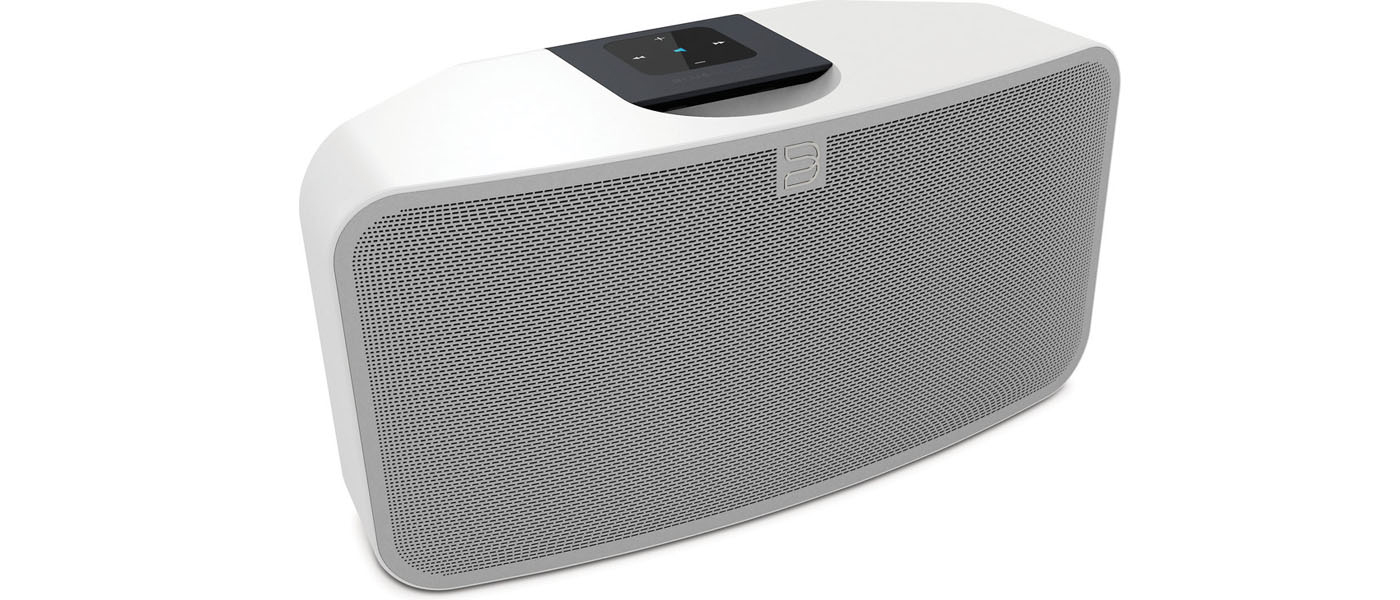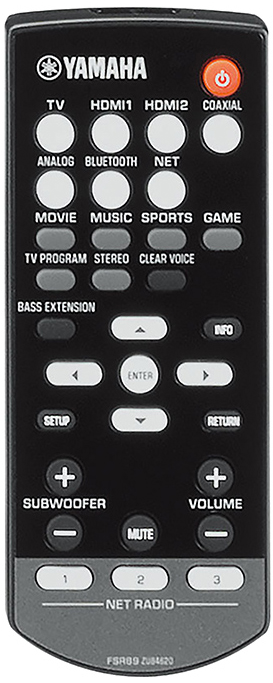Although at this price level, one might consider a good receiver with some thoughtful speaker choices, keeping in mind that the YAS-706 isn’t aiming for the component favoring audiophile.

Yamaha YAS-706 Sound Bar
- Yamaha YAS-706 Sound Bar has HDMI inputs with 4K Ultra HD pass through
- lim design offering wall mount or placement in front of your TV
- Straightforward setup
- Wi-Fi, Bluetooth, AirPlay and Spotify Connect
- MusicCast offers access to Pandora, Spotify, Sirius XM, Deezer, TIDAL and internet radio.
- MusicCast allows integration into a multi-room system
- 2 HDMI inputs may not be enough for many users, although multiple HDMI devices can connect to your TV and then the TV can be connected to the soundbar using the included ARC (Audio Return Channel feature)
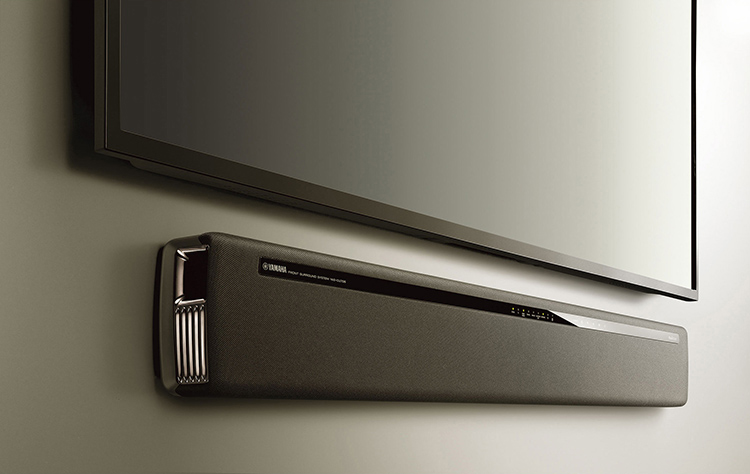
Yamaha has had many years of experience in making sound bars for flat screen TVs and the Yamaha YAS-706 is an evolutionary product designed to keep up with changing home theater specifications and features. The market began when people tired of listening to the tinny-sounding speakers built into most flat screen TVs. Yet many simply didn’t want to go to the bother of stringing wires for multiple speakers, or deal with all the input and output decisions they would have to make. With many screens being wall mounted, a wall mounted sound bar that could greatly improve on built-in speakers seemed a logical option. I have heard a lot of soundbars, in homes and in stores that cater to home theater. Compared to most, the Yamaha is tremendously full featured, incorporating wireless technology, smart phone operation with music services, and integration with 4K video.
Dimensions:
37 3/8” x 2 7/8” x 5 1/8” (sound bar)
11 5/8” x 11 3/4” x 12 1/8” (subwoofer)
Drivers:
Dual 2 1/8” woofers, dual 3” subwoofers, 4 3/4” tweeters (sound bar)
5 1/2” cone woofer (subwoofer)
Weight:
11.9 lbs (sound bar)
20 lbs (subwoofer)
HDMI 2:
In/ 1 Out
Digital Optical:
1 in
Digital coax:
1 in
Analog Audio:
1 in
Subwoofer:
Output
HDMI 4K:
Pass through
Audio Formats:
DTS Digital Surround, HD Audio, Dolby True HD, Dolby Digital Plus, Dolby Digital, Dolby Pro Logic II, DTS-HD Master Audio, DTS-HD High Resolution
Wireless Music Streaming:
Including MusicCast support, Wi-Fi, AirPlay, Bluetooth and Ethernet
App control:
via iOS or Android, Remote
Yamaha YAS-706 Sound bar U.S. MSRP
$999.95
Company:
SECRETS Tags:
Yamaha, Speakers, Sound Bars, Sound Bars Reviews 2017
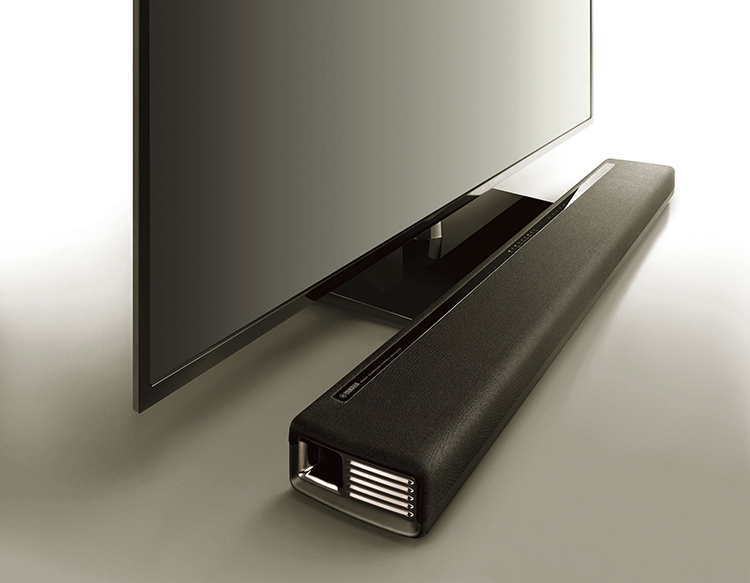
The Yamaha YAS-706 was designed with a great deal of thought about what buyers would need in a sound bar, and how to keep it up to date with the latest demands of home theater technology.
One important feature of this sound bar is what Yamaha calls Air Surround Xtreme. It’s a virtual surround system which Yamaha claims reproduces virtual 7.1 channel sound, offering a clear image up front and “dynamic sound action effects from behind”.
Yamaha provides 285 watts of power, 75 watts of which power the subwoofer while the remainder powers the multiple drivers; a total of 8 speaker drivers and two bass reflex ports.
Secrets Sponsor
Integrating the Yamaha YAS-706 into the proprietary Yamaha MusicCast system allows you to build an entire whole-house music experience with other MusicCast components, similar to the well-known Sonos equipment. Yamaha provides components, powered speakers, and a streaming app that will let you have music throughout your house, playing the same music in every room, or something different in each room. Sources can be server based files, or internet based services like Pandora, Spotify, Napster and more. MusicCast also supports Bluetooth and Apple AirPlay. Up to 9 additional zones can be added to room where the YAS-706 is located.
There are little features that can pay big dividends. The YAS-706 has an extra sub-woofer output if you want to use an additional or a larger wired subwoofer. There’s also a TV remote repeater if the TV IR sensor is blocked by the sound bar. It’s a nice touch, and you don’t see this in every product up for sale.
The YAS-706 was extremely well packed. A quick start guide was immediately visible, and the sound bar itself was in a reinforced box with fitted foam protection. The sub-woofer was in its own well protected box.
The quick start manual covered everything a person would want to know to get things up and running and there is an included CD with a PDF of the manuals for more detail. I’m afraid the days of a comprehensive printed manual are all but dead, but of course you can print the PDF yourself.
The Yamaha YAS-706 comes with built in keyholes for wall mounting, cables for HDMI and optical along with a remote.
Getting your TV and video and audio sources installed is a snap, made even easier by the clearly marked inputs and outputs on the back of the sound bar. One minor com-plaint: If the sound bar is in front of your TV, tilting up the unit puts the labels on the in-puts and outputs upside down, and I think most users will tilt the unit up to get access to the panel. It would have been great to have them reversed for easier reading, or with labels oriented both ways at the top and bottom of the connectors.

There is an HDMI out for connection to your display. It supports ARC (Audio Return Channel) that can send audio sourced from the TV back to your sound bar if you use that feature. Additionally, there’s an optical input for audio out from your TV, another way to get audio from your TV to the sound bar and you don’t want to use ARC, which is sometimes unreliable. There are two HDMI inputs, for any device like a Blu-ray player or set top box. The YAS-706 also sports a coaxial input, RCA analog inputs and a USB connector designed for future firmware updates.
It was really fast getting everything together. The subwoofer connection also showed a lot of thought on Yamaha’s part. Plug the subwoofer into a power outlet. Turn the unit on from a power switch on the back, and it automatically pairs with the sound bar. It worked for me instantly.
Secrets Sponsor
When everything is up and running, you’ll see on-screen menus when you enter the setup mode, which you’ll use for setting up auxiliary services like Sirius/XM radio or other music services. You’ll likely want to connect to your WiFi system for features like AirPlay, Pandora, Napster etc.
I don’t have additional MusicCast speakers or equipment but using either an iOS or Android app along with my WiFi would get the Yamaha MusicCast system enabled letting you stream music or TV sound wirelessly to other parts of your home.
You’ll interact with the Yamaha mainly through the remote. The remote itself is small but well thought out, allowing you too easily adjust the volume of the sound bar, and separately adjust the subwoofer level. There are pre-sets for 3 music services you can specify, and you can engage the ‘Clear Voice’ feature said to enhances voices. You can also select modes like game, movie, sports, and a music only mode that change the frequency curve. I wish all home theater remotes were illuminated. This one isn’t.
The Yamaha YAS-706 is dramatically better than the speakers included in my 55” LG and 45” Samsung TVs. I think anyone moving from internal TV speakers will be quite pleased.
I tested a variety of sources, including Blu-ray movies and concert discs, and programs on satellite TV. I thought the Yamaha subwoofer, in particular, made a noticeable difference. I could not say the same for what Yamaha calls ‘AirSurround Xtreme’, a virtual surround mode.

Playing movies like the Blu-ray of Pacific Rim just did not offer any surround effects that I could sense. When I switched from stereo to surround modes, the Yamaha certainly sounded “different”, as I could hear the results of the ‘virtual sound’ technology being used. The sound field was a bit wider, and had a touch more depth, but the virtual surround sound effect was harder to identify.

I had a detailed listen to Star Wars: The Force Awakens. I really didn’t hear any effects from the rear on those movies either. I was additionally disappointed as this movie has prodigious bass and the subwoofer’s 5 1/2 inch woofer driver didn’t shake my room.
To put the ‘virtual surround’ feature to a better test I put on a couple of tests discs with surround examples and specific tests that can identify front and rear channels with tones. I used the Digital Video Essentials HD Basics Blu-ray test disc, and the Disney World of Wonder Blu-ray. Both discs are designed to help you set up a home theater system. I could easily hear the difference between the left and right channel, but any virtual surround effects (yes, as noted to you above) eluded me. I have, in the past, heard some fair surround demonstrations with some sound bars, but I could not get anything satisfying on the Yamaha listening in two different rooms, a medium sized master bedroom and a small home theater.
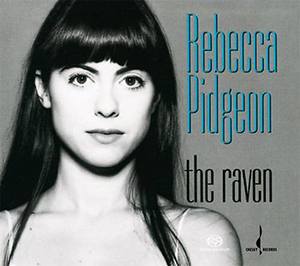
For music listening I mostly had the YAS-706 in stereo mode. The FLAC of Rebecca Pidgeon singing Spanish Harlem from her album The Raven sounded just fine, with a nice stereo spread. This music is a great all around stereo audio test, by the way. Adding the virtual surround modes altered the soundstage slightly as it did on movies, but I did not prefer the extra processing, and Spanish Harlem is a stereo source anyway.
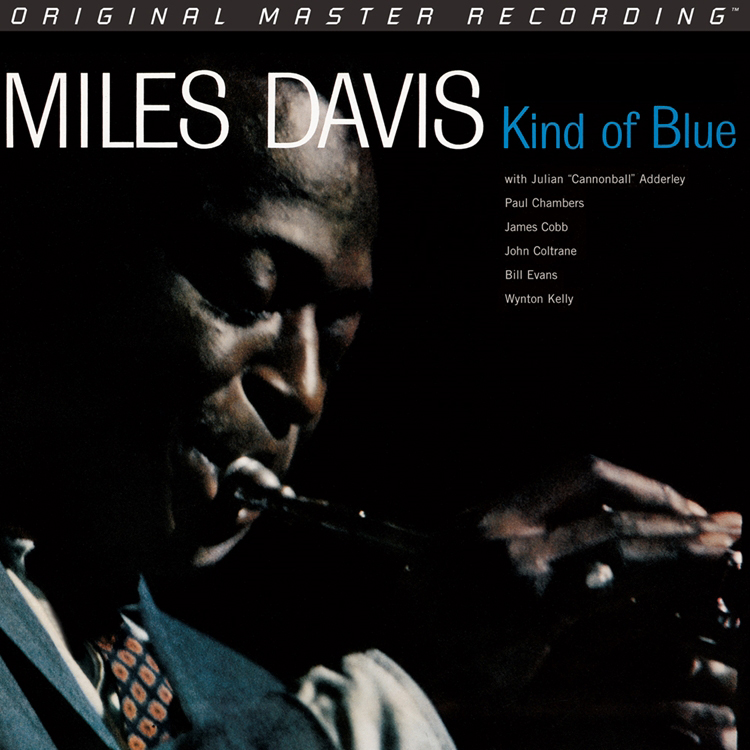
Kind of Blue by Miles Davis on SACD played through a Sony Blu-ray player also sounded quite good, again offering a nice stereo image, switching the subwoofer on helped with some deeper bottom end.
I tried some of the streaming modes and thought they worked well. Getting music off my iPhone and onto the Yamaha worked fine using AirPlay. An Android phone owned by a friend worked equally well. I did not try the wired network connection through Ethernet, but the WiFi connection was faultless and I expect most people will use Wi-Fi rather than have another cable run.
How does the Yamaha YAS-706 sound in comparison to a regular lower end home theater audio system of similar cost? I compared it to a modest and aging Bose Lifestyle system had I felt it had better imaging and deeper bass (from a separate subwoofer). A small receiver with Pioneer bookshelf speakers also sounded more involving. Part of that difference is that the speakers are wider than the width of the sound bar, but part of the difference is the better quality of the separate components.
In a nut shell, that’s the choice consumers have to make: Get a clean 2-piece setup with a sound bar and subwoofer, like the Yamaha YAS-706 and it would be a terrific solution, or a receiver/speaker combination and string those unsightly wires, drawing the ire from your significant other.
From my standpoint, I would argue that at a thousand dollars, with some savvy choices I could put together a better sounding system of components. While the YAS-706 is mostly future-proof with 4K and HDR pass through, it does not offer Atmos or DTS:X, two of the latest surround modes, usually requiring speakers above your head.
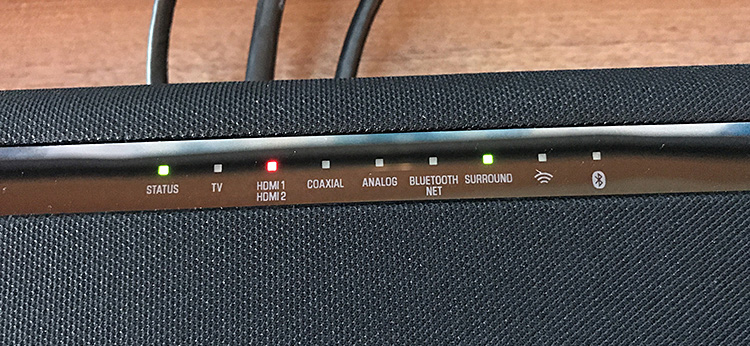
Ergonomically the Yamaha YAS-706 does the job. The back panel is well labeled and clear, although when tilted up, as mentioned earlier, it reads upside down. For people who can simply walk behind it the labels are fine. There are a series of colored LEDs to help identify inputs and modes that are mounted at the top, but they are invisible from a seated position. The way I had my sound bar positioned, they did not reflect up onto the display, which is positive. The LED’s are bright when the remote is operating, but dim a few seconds later. Using the soundbar settings, you can dim the LEDs completely when they are not in use.
THE YAMAHA YAS-706 SOUND BAR is well worth investigating if you take advantage of the MusicCast, multi-room capability and for that alone it stands out among the sound bar offerings.
- Easy setup
- Clearly labeled connections
- Wireless subwoofer
- Clear on-screen menus
- Better sound (larger subwoofer)
- Printed manual
- Illuminated remote
The Yamaha YAS-706 is a good sounding sound bar. It will not leave audiophiles breathless, but it greatly improves on built-in TV audio. It sounds good in medium to small sized rooms but may struggle in larger rooms, where the bass will not be very deep and the speaker spacing will be too narrow.
The Yamaha YAS-706 does not include room calibration, but I think such a feature is a little high-end for the intended audience for this sound bar.
The YAS-706 does has the latest HDMI version, but even the most current equipment can be made obsolete as standards change which is an issue for all products with HDMI connectivity. There are already proposed changes to the HDMI specification; mostly to support 8K TVs, but most experts think that is a few years away, and an 8K TV isn’t likely to be a high priority for most buyers.
The YAS-706 is expensive because of all the streaming and wireless technology that is built-in. A different solution for less money and fewer features might be the Yamaha YSP-1600 that my colleague Glenn Young reviewed last year.
This model is not in the current Yamaha lineup but sells for under four hundred dollars at several outlets. It has a similar feature set but no subwoofer or HDR pass through.


